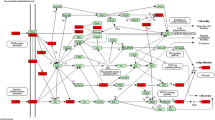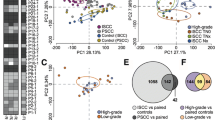Abstract
Gene expression profile of the lung adenosquamous carcinoma was characterized by using cDNA microarray chip containing 4 096 human genes. Among target genes, 508 differentially expressed genes were identified in adenosquamous carcinoma of the lung, 232 genes were overexpressed and 276 genes were underexpressed. Among them, 92 genes are cell signals transduction genes, 34 genes are proto-oncogenes and tumor suppressor genes or cell cycle related genes or cell apoptosis related genes, 29 genes are cell skeleton genes, 28 genes are DNA synthesis, repair and recombination genes, 12 genes are DNA binding and transcription genes. These genes may be associated with the occurence and development of adenosquamous carinome of the lung.
Similar content being viewed by others
References
Perez C A. Nasopharynx. In: Perez C A, Brady L W, eds.Principles and Practice of Radiation Oncology. Third Edition. Philadelphia, PA: Lippincott-Raven Co, 1997. 907–918.
Shimizu J, Oda M, Hayashi Y,et al. A Clinicopathological Study of Resected Cases of Adenosquamous Carcinoma of the lung.Chest, 1996,109(4): 989–993.
Garber M, Troyanskaya O, Schluens K,et al. Diversity of Gene Expression in Adenocarcinoma of the Lung.Proc Nat Acad Sci USA, 2001,98: 13784–13789.
Chomczynski P, Sacchi N. Single-Step Method of RNA Isolation by Acid Guanidinium Thiocyanate-Phenol-Chloroform Extraction.Anal Biochem, 1987,162: 156–159.
Schena M, Shalon D, Heller R,et al. Parallel Human Genome Analysis: Microarray-based Expression Monitoring of 1000 Genes.J Proc Natl Acad Sci USA, 1996,93: 10614–10619.
Gorgoulis V G, Kotsinas A, Zacharatos P,et al. Association of Allelic Imbalance at Locus D13S171 (BRCA2) and p53 Alterations with Tumor Kinetics and Chromosomal Instability (Aneuploidy) in Non-Small Cell Lung Carcinoma.Cancer, 2002,89: 1933–1945.
Yuan B Z, Zhou X, Durkin M E,et al. DLC-1 Gene Inhibits Human Cancer Growth andin vivo Tumorigenicity.Oncogene, 2003,22: 445–450.
Tong X, Kelly J, Xie D,et al. Cyr61 Suppresses the Growth of Non-Small-Cell Lung Cancer Cellsvia the Beta-Catenin-c-Myc-P53 Pathway.Oncogene, 2004,23: 4847–4855.
Bates S, Rowan S, Vousden KH,et al. Characterisation of Human Cyclin G1 and G2: DNA Damage Inducible Genes.Oncogene, 1996,13: 1103–1109.
Jin G, Hu X G, Ying K,et al. Analysis of Gene Expression Patterns in Pancreatic Cancer by cDNA Microarray.Acad J Sec Mil Med Univ, 2000,21: 819–822.
Tanaka K, Nigg E A. Cloning and Characterization of the Murine Nek3 Protein Kinase, a Novel Member of the NIMA Family of Putative Cell Cycle Regulators.J Biol Chem, 1999,274: 1 3491–1 3497.
Pryhuber G S, Huyck H L, Staversky R J,et al. Tumor Necrosis Factor-alpha-induced Lung Cell Expression of Antiapoptotic Genes TRAF1 and cIAP2.Am J Respir Cell Mol Biol, 2000,22(2): 150–156.
Lu Gao-qin, Xu-Shen-hua, Qian Li-juan,et al. The Difference of Gene Expression Profile in Esophageal Carcinoma and Pericancerous Epithelium.Chinese Cancer, 2001,10: 298–300(Ch).
Schneider S, Yochim J, Brabender J,et al. Osteopontin but not Osteonectin Messenger RNA Expression is a Prognostic Marker in Curatively Resected Non-Small Cell Lung Cancer.Clin Cancer Res, 2004,10: 1588–1596.
Spence M J, Streiff R, Day D,et al. Oncostatin M Induces Tissue-type Plasminogen Activator and Plasminogen Activator Inhibitor-1 in Calu-1 Lung Carcinoma Cells.Cytokine, 2002,18(1): 26–34.
Author information
Authors and Affiliations
Corresponding author
Additional information
Foundation item: Supported by the National Natural Science Foundation of China (39870305)
Biography: YANG Fei(1972-), female, Ph. D candidate, research direction: etiology and pathogenesis of lung cancer.
Rights and permissions
About this article
Cite this article
Fei, Y., Jiong, Y., Man, J. et al. Analysis of gene expression profile in lung adenosquamous carcinoma using cDNA microarray. Wuhan Univ. J. Nat. Sci. 9, 967–972 (2004). https://doi.org/10.1007/BF02850810
Received:
Issue Date:
DOI: https://doi.org/10.1007/BF02850810




